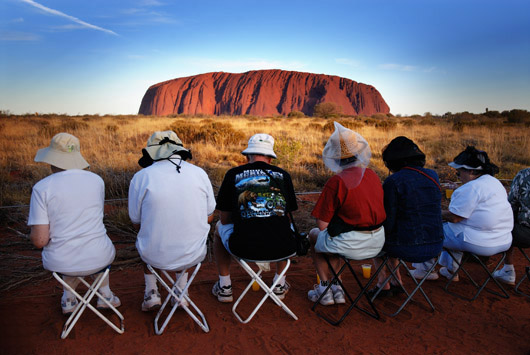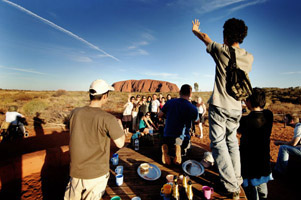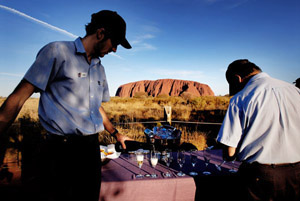Australia,
sulle tracce di Chatwin venti anni dopo Le Vie dei Canti
Palazzo Ducale, Genova
Australia, in Chatwin's footsteps twenty years
after The Songlines
Palazzo Ducale, Genoa


Ritratto
di monolite con turisti. A Uluru i bianchi sono arrivati 130 anni fa.
I primi turisti 70 anni dopo. Impiegavano due giorni per percorrere la
pista da Alice Springs e dormivano in tende piazzate davanti al monolite.
Prima, a parte scienziati, cercatori d’oro e cacciatori di dingo,
gli Anangu (che pensano di essere qui da sempre, gli archeologi suggeriscono
da 22 mila anni) rimasero relativamente indisturbati. Oggi il resort che
è sorto ai margini del parco che circonda Uluru e KataTjuta, al
posto dei motel invasivi di un tempo, ospita migliaia di persone al giorno.
Cinque alberghi (da tre a cinque stelle), un campeggio, undici ristoranti,
cinque piscine, uno shopping center, un aeroporto, un’agenzia che
propone dal giro in cammello all’alba a quello in Harley Davidson
al tramonto, dal volo con la Ayer’s Rock Helicopters, seguendo un
triangolo preciso di corridoi tracciati per non sorvolare luoghi sacri,
alla notte con l’astronomo per osservare le stelle dell’emisfero
australe. La bellezza è un business. La macchina superoleata per
il turismo ruota attorno all’alba e, soprattutto, al tramonto (in
mezzo c’è lo swimming-pool time, un tuffo in piscina, un
pisolino o un giro per souvenir). All’interno del parco hanno costruito
due aree di parcheggio, una per le auto, l’altra per gli autobus.
È lì che avviene lo show. Uluru è la quinta. Nel
parcheggio auto c’è più improvvisazione: c’è
chi si fa bastare uno sgabello e una tazza di tè, chi monta sul
tetto di fuoristrada e camper, chi suona la cornamusa, chi improvvisa
una danza. In quello dei bus regna l’organizzazione standardizzata:
vi sono tavoli dalle tovaglie bianche ricoperti di bicchieri colmi pronti
per il brindisi, gruppi iperorganizzati con sedie pieghevoli e binocoli,
camerieri che servono stuzzichini e champagne a gruppi incentive. Il sole
va giù, lo spettacolo è finito, si replica domani

